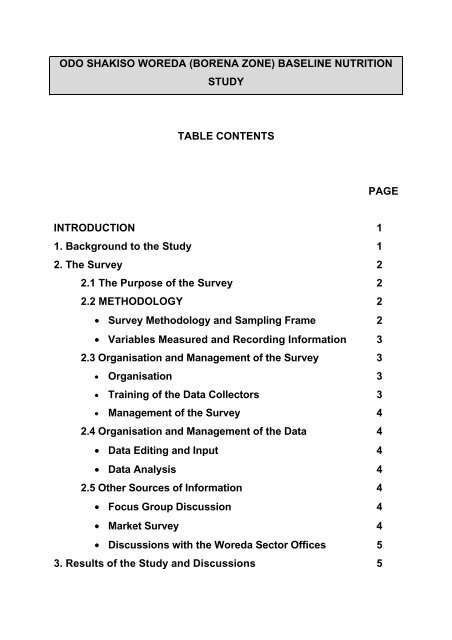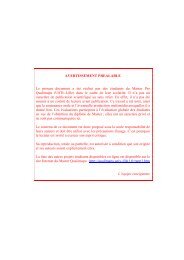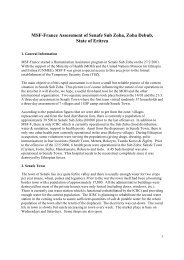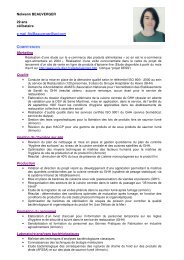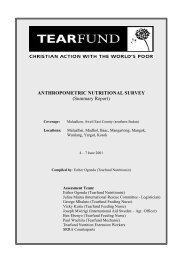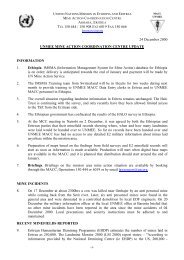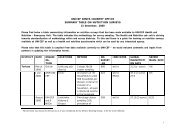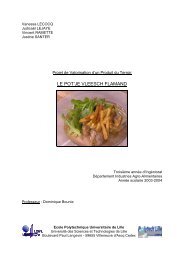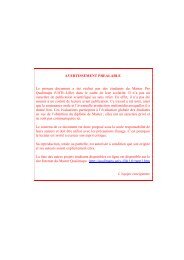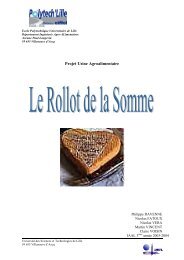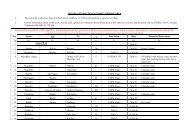ODO SHAKISO WOREDA (BORENA ZONE) - PFEDA / Page d ...
ODO SHAKISO WOREDA (BORENA ZONE) - PFEDA / Page d ...
ODO SHAKISO WOREDA (BORENA ZONE) - PFEDA / Page d ...
You also want an ePaper? Increase the reach of your titles
YUMPU automatically turns print PDFs into web optimized ePapers that Google loves.
<strong>ODO</strong> <strong>SHAKISO</strong> <strong>WOREDA</strong> (<strong>BORENA</strong> <strong>ZONE</strong>) BASELINE NUTRITION<br />
STUDY<br />
TABLE CONTENTS<br />
INTRODUCTION 1<br />
1. Background to the Study 1<br />
2. The Survey 2<br />
2.1 The Purpose of the Survey 2<br />
2.2 METH<strong>ODO</strong>LOGY 2<br />
• Survey Methodology and Sampling Frame 2<br />
• Variables Measured and Recording Information 3<br />
2.3 Organisation and Management of the Survey 3<br />
• Organisation 3<br />
• Training of the Data Collectors 3<br />
• Management of the Survey 4<br />
2.4 Organisation and Management of the Data 4<br />
• Data Editing and Input 4<br />
• Data Analysis 4<br />
2.5 Other Sources of Information 4<br />
• Focus Group Discussion 4<br />
• Market Survey 4<br />
• Discussions with the Woreda Sector Offices 5<br />
3. Results of the Study and Discussions 5<br />
PAGE
3.1 Nutritional status 5<br />
3.2 Vaccination and Health Status in the Studied Children 6<br />
3.3 Socio-economics and Food Situation of the Interviewed<br />
Households 6<br />
• Head of Household and Household Size 6<br />
• Staple Foods of the Family 7<br />
• Pattern in Acquisition of Staple Foods 7<br />
3.4 Family Health Aspects of the Interviewed Households 7<br />
3.5 Sanitation and Water Aspects of the Interviewed<br />
Households 8<br />
• Water Requirement and Source 8<br />
• Changes in Water Supplies and Quantity 8<br />
• Inadequacy of Water Year Round and the Reason<br />
for Shortfall 8<br />
• Intervention Requirements in Water & Sanitation 8<br />
3.6 Focus Group Discussions 9<br />
3.7 Results of Market Surveys 9<br />
4. Discussion on Context 10<br />
4.1 Food Security Situation 10<br />
4.2 Malnutrition Level and Related Stresses 10<br />
4.3 Response to the Crisis 12<br />
5. Recommendations Future Actions 12
EXECUTIVE SUMMARY<br />
This report offers major findings of a baseline nutrition survey that<br />
was commissioned by the Ethiopian Red Cross Society and<br />
undertaken by the consultant in Odo Shakiso Woreda of the Borena<br />
Zone.<br />
Odo Shakiso Woreda is situated in the northern part of the Borena<br />
Zone. The Woreda has a total population of about 100,000 and<br />
organised into 20 Kebele out of which a total of 34,125 people are<br />
affected by the current drought-induced food shortages.<br />
The ERCS and DPPC are distributing regular monthly rations to the<br />
selected 34,125 beneficiaries. Only 4 members in a selected<br />
household are eligible to receive the dry ration of 12.5 kg/head.<br />
ERCS has distributed ration to 7 Kebeles and the rest are covered<br />
by the Federal DPPC.<br />
The Woreda is well known for its rich alluvial gold deposits and<br />
mining that attracts a number of fortune seekers from neighbouring<br />
districts and regions.<br />
Mining itself requires a lot of soil moisture and a great volume of<br />
water for washing the clay off the gold powder.<br />
The attractive forestry and the wildlife are also in great threats in<br />
these non-restricted movements and clearing of trees.<br />
i
NUTRITIONAL STATUS AT THE <strong>WOREDA</strong> LEVEL<br />
LEVEL<br />
Weight-for-<br />
length(WL), n=695<br />
unprotected sources. More than 46.6% of respondent household<br />
have to walk (both ways) for more than 1 hour to fetch water.<br />
Numerous respondents, (58.5%, N=318) reported that they do not<br />
get water year round. The reason for the shortfall is drying of the<br />
sources part of the year.<br />
Water is a scarce commodity in many villages and house. Supply of<br />
clean water is non-existent even in Shakiso town. Private<br />
commercial tankers and donkeys transport water from rivers to<br />
some populated villages for sale.<br />
Recommendations<br />
Strengthening of the ERCS Sub-Branch Offices in Kibre Mengist<br />
and Shakiso and the establishment of warehouses should be an<br />
immediate priority.<br />
The ERCS should strongly advocate for adequate food aid and<br />
inputs in health and water sectors development.<br />
Launch training programs to the Youth Club members about the<br />
activities of the ERCS including food, nutrition, health and the<br />
benefits of wildlife for the community.<br />
Closely monitor the nutritional and health situations in the Woreda<br />
and follow-up nutritional surveys should be conducted every six<br />
months.<br />
Maize grain should constitute a priority grain for general dry ration<br />
iii
distribution and the volume of shipment should be increased for<br />
involvement of the population in food-for-work development<br />
activities.<br />
The possibility of extensive utilisation of able water should be<br />
explored.<br />
The use of baseline information for future project appraisals,<br />
implementation, monitoring and impact evaluation is highly<br />
recommended.<br />
iv
<strong>ODO</strong> <strong>SHAKISO</strong> <strong>WOREDA</strong> (<strong>BORENA</strong> <strong>ZONE</strong>) BASELINE NUTRITION<br />
INTRODUCTION<br />
1. Background to the Study<br />
STUDY<br />
This report offers major findings of a baseline nutrition survey that was commissioned<br />
by the Ethiopian Red Cross Society and undertaken by the consultant in Odo<br />
Shakiso Woreda of Borena Zone (TOR and map of the area are attached in Annexes<br />
Section). A separate brief report about the situation, observed in adjacent Adola-<br />
Wadera Woreda, is also annexed (Annex 4).<br />
Odo Shakiso Woreda is situated in the northern part of the Borena Zone. Borena<br />
Zone is one of the areas that have been affected by drought-induced crop failures<br />
and the precipitating food shortages and ill health.<br />
The Woreda has a total population of about 100,000 and organised into 20 (2 urban,<br />
and 18 rural) Kebele/Peasant Associations (K/PAs) out of which, according to the<br />
authorities of the Woreda, a total of 34,125 people are affected by the current<br />
drought-induced food shortages.<br />
Currently, the Ethiopian Red Cross Society (ERCS) has been involved in the Woreda<br />
in terms of distributing relief food and is making utmost effort in mobilising resources<br />
to contribute towards containing the current food shortages.<br />
Therefore, a need was felt to undertake a baseline nutrition survey of the Woreda to<br />
understand the extent of the need and regulate the ERCS’s assistance as well as for<br />
further advocacy for resources and planning of health, water and nutrition-related<br />
interventions.<br />
1
The report is presented in four parts. The first part deals with the background and<br />
description of the study site while the second part highlights the objectives and the<br />
methodology. The third part presents the major findings of the study. The fourth part<br />
of the report discusses the findings of the study in the context of the current situation<br />
in the in study area and the fifth and final part gives recommendations for further<br />
actions. Detailed accounts of the study results are presented in the appendices and<br />
annexes sections.<br />
2. The Survey<br />
2.1 The Purpose of the Survey<br />
The first and the most immediate purpose of the study were to assess the malnutrition level, to<br />
determine the extent of the need and generate a baseline information on food, health and water needs<br />
of the general population. The survey findings are also thought to support the suggestions to be<br />
forwarded for the immediate and future nutritional and health inputs for action and advocacy.<br />
2.2 METH<strong>ODO</strong>LOGY<br />
• Survey Methodology and Sampling Frame<br />
The consultant, maintaining WHO’s/FAO’s standards and using DPPC guidelines set for such<br />
assessment (as fit for such population dynamics), has designed the study.<br />
A final sample size of 672 children (70-110 cm length) was determined using sample size calculation<br />
method for a 2-stage cluster sample survey (with 30%-estimated prevalence, 5% precision and 5%<br />
error risk). A total of 26 clusters were studied from 6 rural FA/PAs and all eligible children in a<br />
household were included for anthropometric measurement.<br />
2
• Variables Measured and Recording Information<br />
Recumbent length was recorded to the nearest 0.5 cm using standard length board. Each child was<br />
weighed, using hanging spring scale graduated by 0.1 kg, with minimum clothing (estimated<br />
deductions for the minimum clothing were made) and the weight of each child was recorded to the<br />
nearest 100 gram. Wherever available, age and vaccination status have been recorded from their EPI<br />
card whilst the mothers’ responses were recorded in the absence of such a card. Mothers were<br />
interviewed about family food, health and water using structured questionnaires (Annex 2).<br />
2.3 Organisation and Management of the Survey<br />
• Organisation<br />
The survey work was organised into 4 teams consisting of a team leader (a Nutrition<br />
Field Worker) two/three trained assistants (ERCS Youth Volunteers) and a<br />
guide/interpreter. The assistants help the team leader in measuring the children,<br />
recording and filling-in the questionnaires. The guide/interpreter would help each<br />
team in locating the selected Kebele/PA introducing the team. The consultant<br />
supervised the data collection at random to ensure consistency and that the qualities<br />
were maintained.<br />
• Training of the Data Collectors<br />
The survey team leaders and assistants were assigned by the consultant. Although<br />
the team leaders were experienced Nutrition Field Workers (NFWs) who have been<br />
conducting such surveys, a refresher orientation, in the context of the current study,<br />
was given for 2 days in Addis. A further one-day orientation on the survey and<br />
practical training was given to ten assistants selected and provided from the ERCS<br />
Youth Volunteers in Shakiso town (ERCS Sub-Branch Office).<br />
3
• Management of the Survey<br />
Assignment of teams/supervisors and selection of Kebele/Peasant Associations<br />
(K/PA) for each team plus setting of survey dates and times for each cluster were<br />
carried out by the consultant.<br />
2.4 Organisation and Management of the Data<br />
• Data Editing and Input<br />
The data collected were coded, edited and cleaned thoroughly before they are keyed into computer<br />
using EPI-INFO Version 6. Further cleaning of the data was made before computing and tabulations.<br />
• Data Analysis<br />
The standard deviation scores/indexes (Z-Scores) for anthropometric data were calculated with the<br />
help of EPINUT software. Further analysis for associations were performed using and SPSS-PC+<br />
statistical methods.<br />
2.5 Other Sources of Information<br />
• Focus Group Discussion<br />
Focus group discussions were held with key informants and elders in K/PAs to substantiate the<br />
information collected through formal means. The extracts of the findings are summarised and<br />
presented in Appendix A.<br />
• Market Survey<br />
Market surveys were conducted by the teams and the consultant in markets of the<br />
4
Woreda during the study. In most of the cases, the teams/consultant were able to<br />
purchase the items in the smallest unit available. However, for those commodities<br />
difficult to buy such as livestock, the team/consultant presented itself as a buyer and<br />
collected an average price for each item. Results from Woreda Agriculture Office<br />
market surveys are also observed and compared. The findings of these market surveys<br />
are presented in Appendix G.<br />
• Discussions with the Woreda Sector Offices<br />
The Woreda Council, Health and Agriculture offices were visited starting from the initial<br />
stages and during the actual survey. Secondary data and other information pertinent for<br />
the study have been collected during these visits.<br />
3. Results of the Study and Discussions<br />
3.1 Nutritional status<br />
NUTRITIONAL STATUS AT THE <strong>WOREDA</strong> LEVEL<br />
LEVEL<br />
Weight-for-length(WL),<br />
n=695<br />
3.2 Vaccination and Health Status in the Studied Children<br />
The EPI coverage is grouped into two categories; those households that have reported<br />
to have kept the EPI card (11.7%, N=81) and who had no card and responded verbally<br />
(88.3%, N=613). The results indicate that the combined universal coverage of<br />
completion of vaccination totals to 33.1% (N=230 out of 694 total children) (Table C1).<br />
As regards the health status of the studied children in the last 15 days prior to the<br />
survey, the caretakers have reported that 318 (45.8%) out of 694 children were ill. This<br />
is a high level of ill health. Detailed results (Table C2.) show that 45.6% (N=145), 21.4%<br />
(N=68) and 32.7% (N=104) were suffering from fever, diarrhoea, and malaria,<br />
respectively. Prevalence of repeated measles and malarial attacks have been reported<br />
by a number of households and these reports are in agreement with the statements of<br />
officials of local health institutions.<br />
Diarrhoea alone accounted for more than 45% in children indicating a high pattern of<br />
malnutrition. The predisposition of malnutrition to mass diarrhoea in children is common<br />
observation during such food shortages. Attacks of malaria are equally alarming. The<br />
area is an epidemic proportion, currently.<br />
3.3 Socio-economics and Food Situation of the Interviewed<br />
Households<br />
• Head of Household and Household Size<br />
Among the interviewed and responded households (n=545), 91.0% (N=496) are<br />
headed by men while female-headed households are 9.0% (N=49). The reasons for<br />
being female head of a household varied from being widowed 67.9% (N=36), divorced<br />
15.1% (N=8), migrant husband 5.7% (N=3), to shared husband 9.4% (N=5) (Table D2).<br />
The mean household size in the Woreda is 6.8 and the ranges are given in Table D1 in Appendix D. More<br />
than 58% of the respondents constitute 6-13 people living under the same roof. No significant association<br />
was observed between household size and malnutrition level in correlation computations.<br />
6
• Staple Foods of the Family<br />
More than 88% (N=484) of the households have reported maize as their main staple<br />
diet. Few respondents have reported sorghum (9.5%, N=52) and Tef and sorghum<br />
(Table D3).<br />
As regards the source of food, the majority (78.5%, N=428 out of 545) have reported<br />
they purchase from the market. Consumption from their own produce in normal<br />
circumstances accounted only to 11.0 (N=60). The rest, 7.9% (N=43) and 2.6% (N=14)<br />
of the respondents have reported they get the food from wage and aid, respectively.<br />
The survey area has been dependent for years on cash earnings from mining and<br />
related activities.<br />
• Pattern in Acquisition of Staple Foods<br />
Regarding the current position of stock of the reported staple foods in the house, the<br />
majority (96.1%, N=526) of them have reported that they have insufficient food items<br />
under their possession at present (Table D6).<br />
Those who currently buy food (93.4%, N=509) get the money from daily labour<br />
(including mining, 83.6%, N=437), sale of cattle (9.4%, N=49) and sale of firewood<br />
(2.3%, N=12). Income from petty trades accounted to 4.8% (N=25).<br />
3.4 Family Health Aspects of the Interviewed Households<br />
The Woreda has 6 clinics and a Health Post. Most health institutions are said to<br />
conduct MCH programs with EPI and GM/P. Apparent malnutrition (PEM) among<br />
clinics-visiting children are said to be on the rise. Outbreaks of measles, diarrhoea<br />
and malarial epidemics are reported from 6 Kola (lowlands). Drugs, especially<br />
paediatric syrups are not available or are in a short supply.<br />
7
In normal times, when a family member fails sick, 92.3% (N=503) of the interviewed<br />
households go to a government clinic, 3.3% (N=18) of them go to a drug vendor and<br />
2.4% (N=13) go to no where (Table E1). The majority of the reporting communities<br />
have to walk from 2:00 to 5:00 hours to reach the nearest health institution.<br />
3.5 Sanitation and Water Aspects of the Interviewed Households<br />
• Water Requirement and Source<br />
The majority of the survey population (73.9%) interviewed reported daily water<br />
requirements of more than 20 litres. More than 96.8% of the water is from<br />
unprotected sources (Tables F1 and F2). More than 46.6% of respondent household<br />
have to walk (both ways) for more than 1 hour to their water sources (Table F3).<br />
• Changes in Water Supplies and Quantity<br />
Only 13.8% (N=72, n=536) of the respondents have changed their normal water<br />
sources due to the drying up of the source part of the year in their usual source.<br />
• Inadequacy of Water Year Round and the Reason for Shortfall<br />
Numerous respondents, (58.5%, N=318) reported that they do not get water year<br />
round. Reasons for the shortfalls are drying of the sources part of the year (94.9%,<br />
N=299) and high competition (4.4%, N=15).<br />
• Intervention Requirements in Water and Sanitation<br />
In general terms, on one hand, water is a scarce commodity in many villages and<br />
house. On the other hand, it is a common observation to big rivers flowing through<br />
the dense forests of the Woreda.<br />
Supply of clean water is non-existent even in Shakiso town. Private commercial<br />
8
tankers transport water from rivers to some populated villages. Donkeys also play<br />
important roles carrying water from river sources to households or gold mining sites.<br />
Intervention in clean water supply and possible utilisation of rivers for irrigation<br />
(including pump irrigation) should extensively be explored.<br />
3.6 Focus Group Discussions<br />
Focus Group Discussions have been held with key informants and elders. The<br />
participants of all discussions and all key informants unequivocally expressed that the<br />
area has been experiencing a repeated drought (about 6-8 years of gradual crop<br />
failures) and 4 years of total Belg crop failures.<br />
The informants have pointed out that drying rivers, water wells and springs, and<br />
about their children loosing weights, epidemics like scabies and other various health<br />
problems. They reasoned that they are exposed to this type of famine due to<br />
shortages of rain and lack of water. The situations have affected human, animal and<br />
wildlife (forestry) in the Woreda.<br />
The trend in coping strategy was sales of cattle, mining for gold and migration to<br />
neighbouring Enset-growing Woredas like Uraga.<br />
Deaths of considerable number of livestock have been stressed. One member of the<br />
discussion group himself has lost 30 cattle last year.<br />
3.7 Results of Market Surveys<br />
The market study and other survey results obtained from secondary sources are<br />
similar in trends (Appendix G). The market price trend for food grains show an<br />
average 20% to 30% increase from past years during this period. The month to<br />
month pattern was similar. The same level of decline in prices of livestock was being<br />
observed for the same periods. These types of market price patterns are symptoms<br />
of exiting food shortages and nutritional stresses.<br />
9
4. Discussion on Context<br />
4.1 Food Security Situation<br />
The Woreda is well known for its rich alluvial gold deposits and mining (traditional as<br />
well as commercial) attracts a number of fortune seekers (including other service<br />
providers) from neighbouring districts and regions. Therefore, the majority of the<br />
population appear to be unstable and ever moving looking for new and promising<br />
sites for mining and those who do not mine move with the miners to provide the<br />
necessary services like catering, provision of gold-washing water (that is very<br />
scarce), equipment, etc.<br />
Mining itself requires a lot of soil moisture and a great volume of water for washing<br />
the clay off the gold powder. The current drought, therefore, affects not only<br />
agriculture and livestock but mining and the forestry too.<br />
The attractive forestry and the wildlife are also in great threats in these non-restricted<br />
movements and clearing of forests.<br />
The local subsistence farmers also spend a great deal of their time in this very<br />
tedious endeavour. In this context, the lucky ones who get some grams of gold would<br />
flourish whilst those who do not get turn to their homestead. The worst happens<br />
when the backyard crop fails and the cattle starve to death due to drought like that is<br />
in-place now.<br />
4.2 Malnutrition Level and Related Stresses<br />
Odo Shakiso Woreda has recorded one of the highest levels of PEM when compared<br />
with some national and such pocket surveys. The comparative results of some of<br />
these nutritional surveys are summarised in Appendix I.<br />
The 1983 and 1992 national surveys found 8.1% and 8.0% of wasting, respectively.<br />
10
The more recent 1995/96 and 1999 Welfare Monitoring Surveys have recorded<br />
10.8% and 7.6% of wasting, respectively. Although it might not be possible to<br />
compare national figures with this type of specialised study result, 31% of wasted<br />
children in a population of less than quarter of a million could mean the community is<br />
on the threshold of total starvation. The past surveys of the present type have<br />
recorded comparatively lower figures. These include 22.7 in urban setting (Bahir Dar,<br />
MEDAC, 1994), more than 19% in Simada Woreda of South Gonder (Tekabe, 1995),<br />
20.2% in Konso Special Woreda (Tekabe, 1999).<br />
Summary Of Results of Some of the Nutritional Surveys in Ethiopia<br />
Region/ Area Wasting (%) Reference<br />
National (EWS) 7.6 ENI, 1980<br />
National Core Module 8.0 CSA, 1993<br />
Four Towns (FSS)<br />
(Bahir Dar)<br />
South Gonder (BLS)<br />
(Simada)<br />
11<br />
12.3<br />
(22.7)<br />
13.0<br />
(19.6)<br />
MEDAC, 1994<br />
Frew Tekabe, 1995<br />
Selected Woredas (FSS) 8.0 CRS, 1997<br />
National (WMS) 10.8 CSA, 1996<br />
Agro-ecological 10-14 AAU, 1994 (PC)<br />
National (WMS) 7.6 CSA, 1999<br />
Konso Special Woreda (BLS) 20.2 Frew Tekabe, 1999<br />
The acute malnutrition proportion observed in Odo Shakiso Woreda, therefore, is<br />
indicative of a prevailing household food insecurity and deteriorating nutritional and<br />
health situation.
4.3 Response to the Crisis<br />
In recognition of the relief needs of the population of the area, the ERCS and DPPC<br />
are distributing regular monthly rations to the selected 34,125 beneficiaries. The<br />
selected beneficiaries are reported to have been receiving 12.5 kg per head. Only 4<br />
members in a selected household are eligible to receive the dry free ration. ERCS<br />
distributes general dry ration to 7 (2 urban and 5 rural) Kebeles and the rest are<br />
covered by the Federal DPPC.<br />
5. Recommendations Future Actions<br />
5.1 Strengthening of the ERCS Sub-Branch Offices in Kibre Mengist and<br />
Shakiso should be an immediate priority. Establishment of related<br />
logistics like warehouses (central and satellite), transport means, etc., is<br />
essential.<br />
5.2 Sensitisation of policy makers at the Woreda, Zone and Regional levels<br />
and with all those concerned with the welfare of the affected population<br />
should be the priority task of the ERCS. The ERCS should strongly<br />
advocate for adequate food aid and inputs in health (including essential<br />
drugs) and water sectors development.<br />
5.3 Increase the number of members and Youth Club members. Launch<br />
training programs to the Youth Club members about the activities of the<br />
ERCS including food, nutrition, health and the benefits of wildlife for the<br />
community (humanity) and the nation as a whole.<br />
5.4 The Kibre Mengist Sub-Branch Office in collaboration with the local<br />
health institutions, the Woreda Council, and the Woreda Agricultural<br />
Offices should closely monitor the nutritional and health situations.<br />
Follow-up nutritional surveys (at least with smaller samples) should be<br />
conducted every six months.<br />
12
5.5 Maize grain should constitute a priority grain for general dry ration<br />
distribution and the volume of shipment should be increased for<br />
involvement of the population in food-for-work development activities.<br />
Sorghum should be additional alternative grain for general distribution<br />
(free and development).<br />
5.6 The agriculture based development strategy of the country emphasises<br />
on the development of the agricultural sector through the increased<br />
utilisation of improved seeds, fertilisers, improved agricultural<br />
technologies, farmers access to credit, training, information and<br />
extension services. Free or subsidised (plus credit) distribution of early-<br />
maturing crop seeds and introduction of root crops be encouraged. The<br />
ERCS, in collaboration with the Woreda Council and Woreda Agriculture<br />
Office, should look for the sources of these inputs.<br />
5.7 The available water should be developed for sanitation and micro-<br />
irrigation schemes. Some of the free-flowing rivers appear to be feasible<br />
for use in backyard gardening and the like with the help of pumps. The<br />
possibility of their extensive utilisation should be explored.<br />
5.8 Development and/or rehabilitation activities for roads, forestry, soil,<br />
water and wildlife conservation are essential. The ERCS should, in<br />
collaboration with the line ministry offices in the Zone and the Woreda,<br />
lobby for these inputs and advocate for other agencies to contribute<br />
towards establishment or strengthening of these development schemes.<br />
5.9 The uses of baseline information, generated from the present survey in<br />
the area, for future projects (including development programs)<br />
appraisals, implementation, monitoring and impact evaluation is highly<br />
recommended.<br />
13


